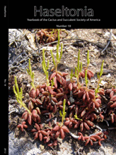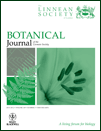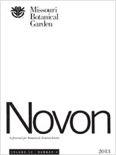
Bangladesh Journal of Plant Taxonomy
Scope & Guideline
Innovating research in plant taxonomy and conservation.
Introduction
Aims and Scopes
- Plant Taxonomy and Systematics:
The journal emphasizes the classification and naming of plants, including studies on new species, taxa revisions, and systematic relationships among various plant families. - Biodiversity and Flora Studies:
It aims to document and analyze the diverse flora of Bangladesh, including inventories of vascular plants, and studies on specific regions or ecosystems. - Ethnobotany and Medicinal Plants:
Research on the traditional use of plants for medicinal purposes is a core focus, highlighting the ethnobotanical knowledge of local communities. - Molecular Phylogenetics and Genetics:
The journal includes studies utilizing molecular methods to explore genetic relationships and phylogenetic analyses, contributing to a better understanding of plant evolution. - Environmental and Ecological Research:
Investigations into the effects of environmental factors on plant species, including studies on salinity, climate change, and ecological interactions.
Trending and Emerging
- Molecular Characterization and Genomics:
There is a notable increase in studies utilizing molecular techniques for the characterization of plant species, including genome sequencing and phylogenetic analyses, highlighting a trend towards integrating molecular biology into taxonomy. - Impact of Climate Change on Plant Biodiversity:
Research addressing the effects of climate change on plant species and ecosystems has gained traction, reflecting a global concern for biodiversity conservation in the face of environmental changes. - Ethnobotanical Research in Local Contexts:
The exploration of ethnobotanical knowledge, particularly regarding medicinal plants and their uses in local communities, is becoming more prominent, emphasizing the integration of cultural practices within botanical studies. - Ecological Studies on Plant Interactions:
Emerging papers are increasingly focusing on ecological interactions among plant species, including studies on community structure, biodiversity patterns, and plant responses to environmental stressors.
Declining or Waning
- Traditional Agricultural Practices:
Research on traditional agricultural practices and their impact on plant diversity has decreased, possibly due to a growing interest in modern agricultural techniques and biotechnology. - General Flora Surveys without Specific Focus:
More generalized flora surveys that do not delve into specific taxonomic or ecological aspects have become less common, as researchers increasingly aim for targeted studies with detailed methodologies. - Invasive Species Studies:
Papers focusing on the impacts of invasive species on local flora have diminished, indicating a potential shift towards more pressing issues such as climate change and habitat degradation.
Similar Journals

BANGLADESH JOURNAL OF BOTANY
Cultivating Research in Plant SciencesBANGLADESH JOURNAL OF BOTANY is a prominent publication in the field of plant sciences, dedicated to advancing research and knowledge within the botanical community. Published by the BANGLADESH BOTANICAL SOC, this journal serves as a vital platform for researchers and scholars seeking to disseminate their findings related to plant biology, ecology, and conservation practices, particularly within the unique context of Bangladesh's diverse flora. With an ISSN of 0253-5416 and an E-ISSN of 2079-9926, the journal encompasses a wide scope of topics, reflecting interdisciplinary approaches in botanical research. Since its inception, with convergence periods from 1996 to 2001 and from 2003 to 2024, it has garnered recognition, positioned in the Q4 category in the Plant Science field with a ranking of #459/516 in Scopus, indicating its contribution to the field despite its developing impact. Operating within Bangladesh, at the UNIV DACCA DEPT BOTANY, the journal provides a crucial insight into the ecological and agricultural implications of plant studies in the region, catering to the needs of academics, professionals, and students eager to engage with contemporary botanical research.

PLANT SYSTEMATICS AND EVOLUTION
Unveiling the Mysteries of Plant DiversityPlant Systematics and Evolution is a prestigious journal published by Springer Wien, dedicated to advancing research within the fields of plant taxonomy, evolution, and ecology. With its ISSN 0378-2697 and E-ISSN 1615-6110, this journal has been pivotal in shaping the scientific landscape since its inception in 1974. Based in Austria, it occupies a significant position in the academic community, being ranked in the Q2 quartile in both Ecology, Evolution, Behavior and Systematics and Plant Science as of 2023. This high-impact journal is recognized for its rigorous peer-review process and is indexed among the top publications in its category, holding a Scopus rank of #176 out of 516 in Plant Science and #252 out of 721 in Ecology, highlighting its relevance and quality in the research community. Although it does not currently offer open access, the journal is committed to making significant contributions to the understanding of plant biodiversity and evolutionary processes. This makes it an essential resource for researchers, professionals, and students aiming to know the latest developments in the study of plant systematics and evolution.

HASELTONIA
Cultivating Insights into Cacti and SucculentsHASELTONIA is a distinguished journal published by the CACTUS SUCCULENT SOC AMER INC, focusing on the field of plant science with particular emphasis on cacti and succulent plants. With an ISSN of 1070-0048 and an E-ISSN of 1938-2898, this journal has carved a niche for itself in the academic community, boasting a 2023 Scopus rank of #204 out of 516 in Agricultural and Biological Sciences, placing it in the 60th percentile. HASELTONIA spans several converged years from 2002 through 2024, reflecting its commitment to publishing pertinent and timely research. This journal is recognized for its significant contribution to the understanding and conservation of succulent flora and is classified in the Q2 category in Plant Science, indicating a solid impact in the field. HASELTONIA aims to promote research collaboration, disseminate innovative findings, and foster knowledge sharing among researchers, professionals, and students alike, making it an essential resource for anyone dedicated to the study and appreciation of plant diversity.

BOTANICAL JOURNAL OF THE LINNEAN SOCIETY
Fostering Innovation in Botanical Research and TheoryThe Botanical Journal of the Linnean Society, published by Oxford University Press, stands as a premier platform for interdisciplinary research within the realms of Ecology, Evolution, Behavior, and Plant Science. With a notable impact factor reflective of its esteemed reputation, this journal is classified in the Q1 quartile for both Ecology and Plant Science, placing it among the most influential publications in these fields. Since its inception in 1969, and with an anticipated convergence of research extending to 2024, it has become essential for scholars and professionals seeking to engage with cutting-edge studies, theoretical frameworks, and practical applications that drive our understanding of plant biology and ecological systems. The journal’s commitment to excellence is underscored by its robust Scopus rankings—achieving an impressive 83rd percentile in Ecology and a 82nd percentile in Plant Science. This makes the Botanical Journal of the Linnean Society a crucial resource for researchers, educators, and students alike, eager to advance their knowledge and contribute to the evolving discourse in botany and environmental studies.

ADANSONIA
Innovating research in the heart of plant biology.ADANSONIA is a distinguished, peer-reviewed open access journal dedicated to advancing the field of plant science. Published by the Publications Scientifiques du Museum in Paris since 2000, this journal serves as a critical platform for sharing innovative research and discoveries in botany, ecology, and related disciplines. With its ISSN 1280-8571 and E-ISSN 1639-4798, ADANSONIA boasts a notable Scopus rank of #383 in the Agricultural and Biological Sciences category and a 2023 category quartile ranking of Q3 in Plant Science, indicating a meaningful contribution to the academic community. The journal's scope encompasses a broad range of topics, making it a vital resource for researchers, professionals, and students alike who are exploring the complexities of plant biology. Based in France, ADANSONIA not only enhances visibility for groundbreaking research but also facilitates open communication amongst scholars, ensuring that knowledge on plant science is accessible worldwide. Located at CP 39-57, Rue Cuvier, F-75231 Paris Cedex 05, France, this journal stands as a testament to the collaborative efforts in the pursuit of scientific excellence in plant sciences.

Mediterranean Botany
Exploring the Richness of Mediterranean FloraMediterranean Botany is a distinguished peer-reviewed journal dedicated to the flourishing fields of Ecology, Plant Science, and Ecology, Evolution, Behavior and Systematics. Published by the Universidad Complutense de Madrid, Servicio Publicaciones, this Open Access journal has been disseminating valuable research since 2018, ensuring that findings are accessible to a global audience, with an emphasis on Mediterranean vegetation and biodiversity. With an ISSN of 2603-9109, it contributes significantly to the academic discourse in its category quartiles, recently featuring in Q3 for Ecology and related fields. Notably, Mediterranean Botany ranks within the top half of its category in Scopus, highlighting its relevance and contribution to the scientific community. Researchers, professionals, and students alike will find the journal to be a vital resource for latest discoveries, trends, and conservation strategies in Mediterranean ecosystems, positioning it as an essential platform for advancing knowledge and fostering collaboration within the plant sciences.

TAXON
Championing high-impact research in ecology and evolution.TAXON is a premier international journal published by Wiley, dedicated to the fields of ecology, evolution, behavior, systematics, and plant science. With a distinguished history since 1970 and a commitment to advancing knowledge in the biological sciences, TAXON has been recognized in the Q1 category for both its ecological and plant science contributions as of 2023. The journal boasts an impressive Scopus ranking, placing it in the 76th percentile for Ecology, Evolution, Behavior and Systematics and the 74th percentile for Plant Science, highlighting its significance and impact within these domains. While not an open-access publication, TAXON offers a wealth of high-quality research articles, reviews, and discussions, making it an indispensable resource for researchers, professionals, and students alike seeking to deepen their understanding of biodiversity and systematics. For access to its cutting-edge research, readers can follow the journal's updates and contributions online.

GAYANA BOTANICA
Connecting scholars with the latest in plant ecology.GAYANA BOTANICA is a prominent academic journal that specializes in the fields of Ecology, Horticulture, and Plant Science, published by EDICIONES UNIV, CONCEPCION in Chile. Established in 1981, this journal has become a vital resource for researchers and professionals seeking to advance their knowledge and contribute to the understanding of botanical sciences, offering a diverse range of articles that explore the ecology of plants, horticultural practices, and innovative plant science methodologies. Although it currently holds a Q4 quartile ranking in its categories, the journal’s commitment to disseminating valuable scientific findings continues to strengthen its relevance in the field. With its focus on promoting original research and fostering dialogue among scholars, GAYANA BOTANICA plays an essential role in supporting the global scientific community. We invite researchers, academics, and students to engage with its content and explore advancements that are shaping the future of plant sciences.

NOVON
Connecting Research to ConservationNOVON is a premier scholarly journal published by the Missouri Botanical Garden, focusing on the intersection of botany and taxonomy, particularly within the fields of Ecology, Evolution, Behavior, and Systematics. Since its inception in 1994, NOVON has established itself as a vital resource for researchers seeking insight into plant science and related disciplines, reflected in its Q3 ranking in 2023 within both Ecology and Plant Science categories. With a commitment to advancing knowledge in these dynamic fields, the journal serves as a platform for innovative studies and significant findings. Although it currently operates without an open-access model, NOVON provides valuable contributions to the scientific community, fostering collaboration and dialogue among professionals and students alike. Located in St. Louis, Missouri, the journal plays a crucial role in enhancing our understanding of biodiversity and plant evolution, supporting the overarching objectives of conservation and ecological research.

NEW ZEALAND JOURNAL OF BOTANY
Fostering Innovation in Plant Science ResearchThe New Zealand Journal of Botany, published by the esteemed Taylor & Francis Ltd, serves as a pivotal platform for disseminating significant research in the fields of Ecology, Evolution, Behavior and Systematics, as well as Plant Science. With a rich history dating back to 1963 and an impressive convergence extending to 2024, this journal has established itself as an essential resource for researchers and professionals dedicated to understanding the complexities of plant life and ecological systems in New Zealand and beyond. The journal is currently categorized in the Q3 quartile for both relevant disciplines as of 2023, reflecting its balanced influence within the global academic community. Although not an open access journal, it retains a significant impact factor, evidenced by its Scopus rankings, which place it within the top half of its categories. This makes it an invaluable tool for students, researchers, and academics aiming to engage with robust, peer-reviewed scientific findings and contribute to the evolving discourse surrounding botany and ecological research.